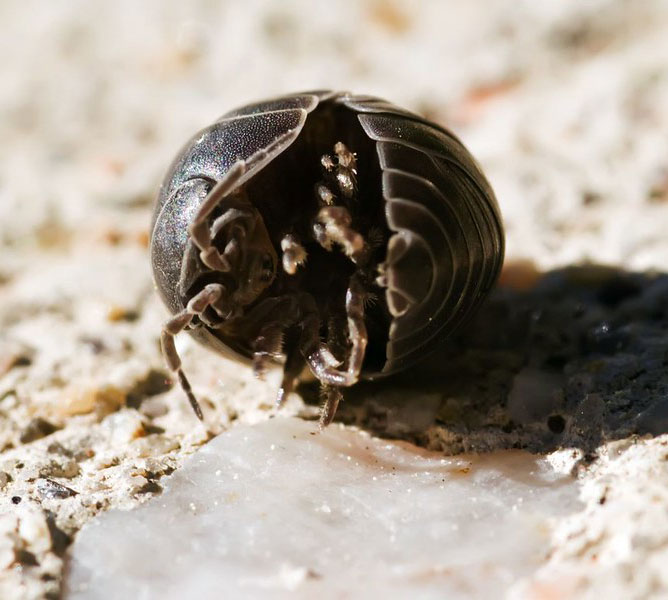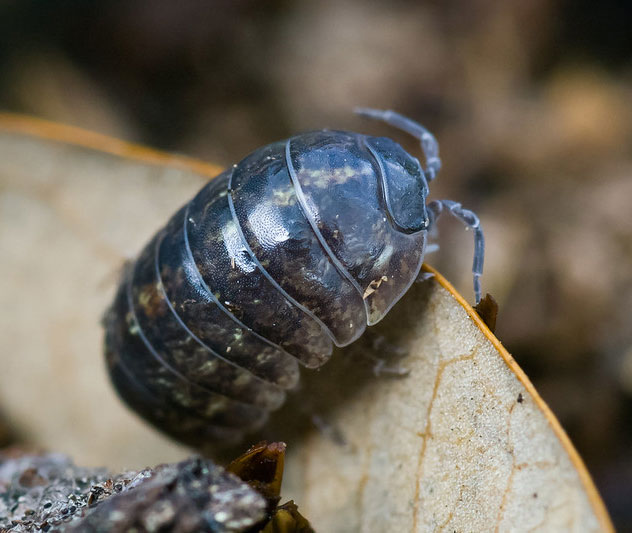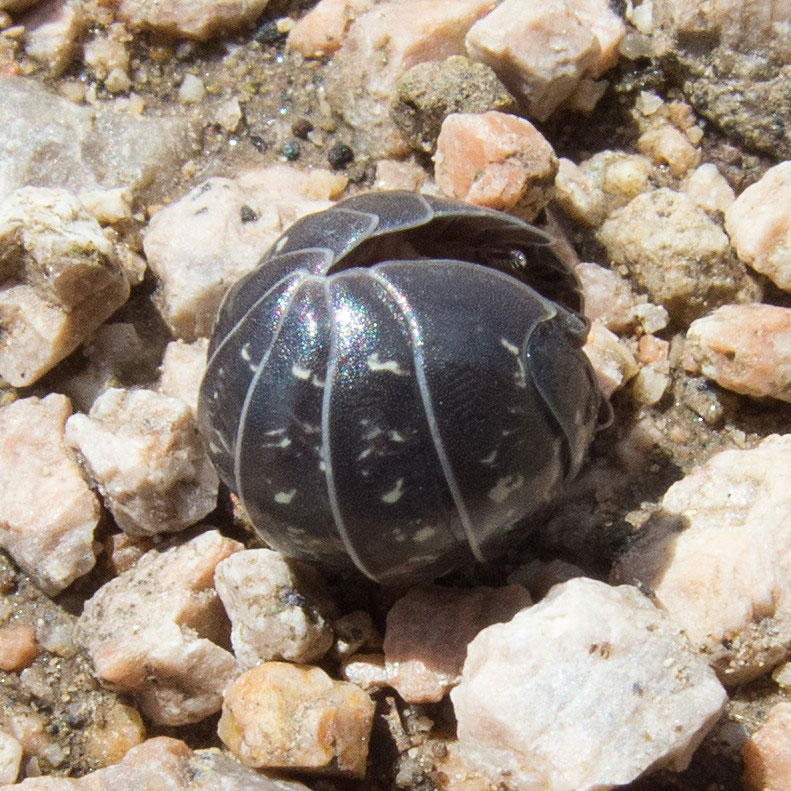Most people assume that Pillbugs (scientific name: Armadillidium vulgare), also referred to as rolly pollies, potato bugs, pill millipedes, doodlebugs, slaters, sow bugs, poly bugs, are insects. However, pill bugs, which are in the family Armadillidiidae (a family of wood lice), are actually crustaceans. This may come off as a surprise to many.
However, these creatures are actually more closely related to shrimps and lobsters than they are to beetles or crickets. Unlike land insects and animals, rolly pollies breathe through gills.
It turns out that millions of years ago, pill bugs migrated from the sea to land probably due to stiff competition in the ocean or for some other reasons.

One of the most distinguishable features of pill bugs is their ability to roll their bodies into a ball shape, a process known as conglobation. This unique behavior is commonly seen in pill millipedes (often confused with pill bugs), cuckoo wasps, and armadillos.
As strange as it may seem, there are people who actually consider pill bugs to be interesting and therefore opt to keep them as pets at their homes. There are others who consider them pests as although their diet is mainly composed of moist decaying matter, they also consume living plants such as leaves, tubers, roots, shoots, and fruits in gardens.
Whether you’re looking to keep a few rolly pollies as pets or simply want to eradicate them from your kitchen garden or lawn, you’ve probably wondered “what do rolly pollies eat?”
Rolly Polly Diet
Rolly pollies mainly consume organic plant matter that is already decaying or decomposing. They aren’t fussy eaters and can consume pretty much everything. Although they are not exactly bugs, rolly pollies have a diet that is pretty similar to that of common bugs.
They eat decaying matter such as leaf litter, grass, and even wood fibers. They are able to survive on such stuff for years – pill bugs have a typical life span of 2 to 5 years.

They also consume cardboard as well as rotting food. Therefore if you intend to keep them as pets, you’ll need to ensure that the food is rotten but not moldy. It turns out that these little crustaceans are not really good at processing moldy food and can actually die after consuming such foods.
Their diets are not restricted to decaying or decomposing organic matter though. Like I stated earlier, pill pugs are not picky eaters and will thus also eat living plants, particularly those in wet conditions. These include fresh leaves, roots, stems, shoots, tubers, and even fruits. Pill bugs eat stink bugs eggs as well and for this reason, they might actually be good to have around.
In farming areas prone to flooding and heavy rains, pill bugs typically feed on numerous plants such as beans, peas, corn, spinach, potato, strawberries, melon, chard, cucumber, and beet. Because they consume live plants which leads to significant yield loss, pill bugs are often considered serious pests.
Some roly pollie species also have strange eating habits. They are known to eat their own feces, feces from other animals, and even decaying or decomposing animal flesh.
Pill bugs are also nocturnal feeders and are inactive during the day. You’ll find them hiding in dark and humid areas such as under rocks, logs, and fallen leaves during the day.
Pill Bugs’ Contribution to the Ecosystem as Decomposers
During feeding, pill bugs are able to take in heavy metals such as copper, lead, zinc, and cadmium. This way, they are able to temporarily remove many of these toxic metals from the soil, thus creating a healthy ecosystem. After they die and decompose, these metals are returned to the soil and the process continues. Thus, their contribution to the environment is immense.
Do Rolly Pollies Need Water? What do rolly pollies drink?
Rolly Pollies don’t really „drink” water, but instead have gills that allow them to obtain enough water from the moisture & humidity in their habitats. If exposed to an open water source, these little critters may drown. That’s why you won’t find them living in ponds or swimming pools.

Because they typically live in habitats with high levels of humidity, moderate temperature levels, and reduced illumination, the chances of severe dehydration are quite low. If you have some rolly pollies in a terrarium, then be sure to just mist the cage with a water bottle from time to time to keep the air humid.
Pill bugs are also able to reduce respiratory water loss by curling their bodies into a tight ball shape.
How Often do Rolly Pollies Eat?
As long as food is available, rolly pollies are able to consume as much as they want. However, in the event of food scarcity, their food consumption drops significantly.
If you’re keeping some as pets, be sure to provide as much food as possible.
What Eats Rolly Pollies?
Rolly pollies are commonly hunted by birds, toads, frogs, wasps, spiders, some ants, and millipedes.
Can Rolly Poly Bite You?
Unlike many insects and bugs, rolly pollies do not bite, sting, or carry harmful diseases. This is why there are many people who are able to safely keep them as pets.
Are Rolly Pollies Poisonous?
No, rolly pollies are not poisonous. And as stated earlier, they don’t sting, bite, or carry any harmful diseases.
Are Rolly Pollies Bad?
Because they tend to feed on live garden plants like shoots, roots, leaves, and even fruits, rolly pollies are often considered as pests. Although they do play an important role in temporarily removing heavy metal deposits from soil, most people are often looking for ways to eradicate them due to the damage they cause.
They are safe to keep as pets but may cause damage to your kitchen garden plants.
What are Rolly Pollies a Sign Of?
Rolly pollies in your home are a sign of moisture problem. If you find these bugs in your home, then you may have a serious moisture problem that needs to be addressed soon. As stated earlier, rolly pollies love habitats with high humidity levels, moderate temperature levels, and reduced exposure to sunlight.
How Do You Tell if a Rolly Polly is a Boy or Girl?
You can easily tell whether a rolly polly is a boy or girl by looking at their undersides. A boy pill bug typically has a darker shell while female pill bug has a lighter shell with some brown dots.
The males also have longer antennas compared to females. Females can also be easily distinguished by a pouch on their underside where they carry babies when pregnant.
Males will often mount on females during mating.
Bottom Line
If you’re dying to have a pill bug are your pets, then it’s important that you learn what it eats beforehand. Generally, rolly pollies eat pretty much anything that is decaying or decomposing, but they also don’t mind adding fresh foods to their diets. They don’t sting or bite and as funny as it may seem, they can actually make very good pets.

Lydia King is a huge animal lover and has always been fascinated with learning about the animal kingdom. She enjoys writing about anything animal related from scientific information about rare species to animal references in pop culture.












